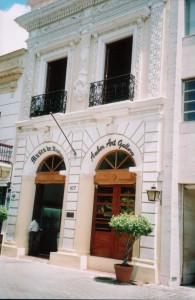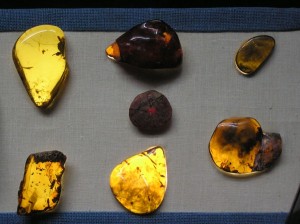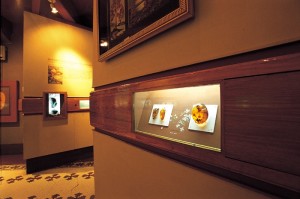Not all Caribbean treasures wait to be discovered in chests hidden in long-forgotten sites – a visit to the Dominican Republic can also provide a fascinating glimpse into the world of semi-precious stones to be found around this island nation. In fact, the island of Hispaniola, which the Dominican Republic shares with neighboring Haiti, is renowned among gemologists for its semi-precious stones of both amber and larimar that have been uncovered here. Nowadays, the traveler can also access that background along with a visual exploration and perhaps even an item suitable for either personal or decorative use as a fine reminder of the journey here.

Around Santo Domingo – Museums and More
While amber can be found and purchased from other locations within the Americas and beyond, the role it has played in the story of the Dominican Republic is perhaps more significant. To begin an exploration of amber and its presence in the Dominican past and present, the capital’s old quarter or Zona Colonial is an ideal starting point for viewing a variety of this semi-precious stone. At the Museo de Ambar (Amber Museum), located along the quarter’s central Parque Colón, there is a small upstairs museum above a gift shop filled with carefully labelled exhibits of amber and related items on display, detailing the history of this semi-precious stone over the centuries on Hispaniola. The mining for amber takes places in just two main locations in the country, and on hand are pieces of the stone representing the full range of what is extracted here. Their color spectrum runs from a pale yellow to a honey gold and down to deeper shades of orange and rich brown hues.
Some of the samples of amber on display here are so ancient that the insects – ants, wasps and others – trapped and preserved within them date back beyond thousands of years. The development of the amber mining industry and the various uses made of the stone – everything from decorative jewelry to decorative items for the home or display are also on display here. Downstairs in the shopping area, display cases are stocked with jewelry inset with amber. The visual and historical backdrop of the museum provides an insight to an unusual gem popular as a gift or memento of the Dominican Republic.
Also to be found in the Zona Colonial is a more extensive exhibit of ambar at the Museo Mundo de Ambar (World of Ambar Museum). Samples here include both local Dominican and pieces from around the world, and the display outlines in considerable detail the history of the stone stretching from the early millennia into the present day. The ancient origins of amber are evident in the fossilized preservation of insect life from prehistoric periods – insects, bugs and ants held in a transparent infinity.

While amber has a well-established history of human use going back through the ages, another even more unusual stone of Dominican origin is the semi-precious gem called larimar. In fact, larimar was first brought to wider attention just in the Seventies by a former American peace corps worker who managed to trace pieces of if back to its underground source in the Dominican interior countryside. A lovely soft shade of blue verging on azure in color, the cut and finished use of this stone makes for an ideal pair of earrings, necklace setting or inset motif on a decorative creation.
At the Museo Larimar (Larimar Museum), an extensive and modern showcase of the larimar explains its background and emergence as a valued semi-precious stone suitable for jewelry nowadays. On a quiet stretch of street within the Zona Colonial, visitors can go upstairs to this small but well organized museum that details the brief history – the struggle for control of the stone’s mining, its geological provenance, how it continues to be extracted and brought to the wider world. Some of this description also attributes unusual qualities to the larimar; for instance, it is said to have a calming, serene effect for those wearing it, an ability to promote a well-balanced mind-body connection. Whatever you choose to believe, you may still be drawn to some of the exquisitely fashioned jewelry and ornaments available for sale in the ground-floor shop as you move on. The larimar stone also comes in several hues other than its blue-green variations, although the azure will probably be the most prominent and striking you see on display around the Dominican Republic.

Puerto Plata and Beyond
The legacy of amber is also accessible beyond the Dominican capital – and a stop off at some locations in the northern coastal town of Puerto Plata is more than worthwhile. Here at a converted former nineteenth century mansion in the city’s historic district, you come across the Museo del Ambar Dominicano (Museum of Dominican Amber). Visitors can either take a guided tour in English or Spanish, or look at the extraordinary preservation dating back millennia that showcases pieces of amber that often contain the fossilized worlds of the prehistoric. Again, amber serves as a sort of time capsule of the period of its formation, with plant and insect life dating back millions of years. The onsite museum gift shop also provides another chance to acquire a piece of either amber or larimar. Also within Puerto Plata and presenting the amber stone in addition to a wider spectrum of major contemporary Dominican products – including rum, sugar, tobacco and coffee – is the Galeria de Ambar (Amber Gallery), which has a section dedicated solely to the stone, with signs in both English and Spanish.
Both amber and larimar turn up frequently enough in finer gift shops around the Colonial Zone of the capital, and in Puerto Plata and other larger visitor destinations around the island to make a good selection for purchase possible. Once you explore and appreciate the background of the Dominican Republic’s national semi-precious gems, do well by yourself also in dealing with a reputable vendor and knowledgeable salesperson in acquiring your own samples. Beside the outer attractive qualities of color or shape or design within a piece of jewelry, always also ascertain the authenticity of that stone itself.
Dominican Amber and Larimar – Addresses and Hours
Museo de Ambar (Ambar Museum) – El Conde #107, on Parque Colón; Tel: 809-221-1333
Museo Mundo de Ambar (World of Amber Museum) – Arzobispo Merino 152, Zona Colonial, Santo Domingo; Tel: 809-682-3309; www.amberworldmuseum.com
Museo de Larimar (Larimar Museum) – Isabel La Católica with Padre Billini, Zona Colonial, Santo Domingo; Tel: 809-682-3309; www.larimarmuseum.com
Museo del Ambar Dominicano (Dominican Amer Museum) – Duarte 61, Puerto Plata; Tel: 809-586-3910; www.ambermuseum.com
Galeria de Ambar (Amber Gallery) – Calle 12 de Julio, Puerto Plata; Tel: 809-586-6467; www.ambercollection.itgo.com

